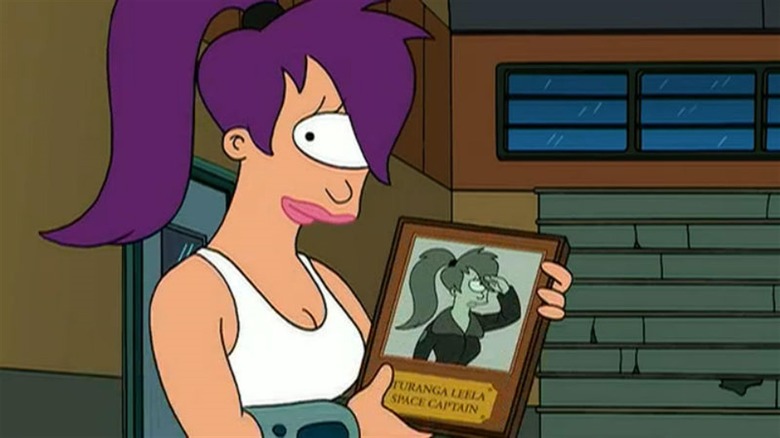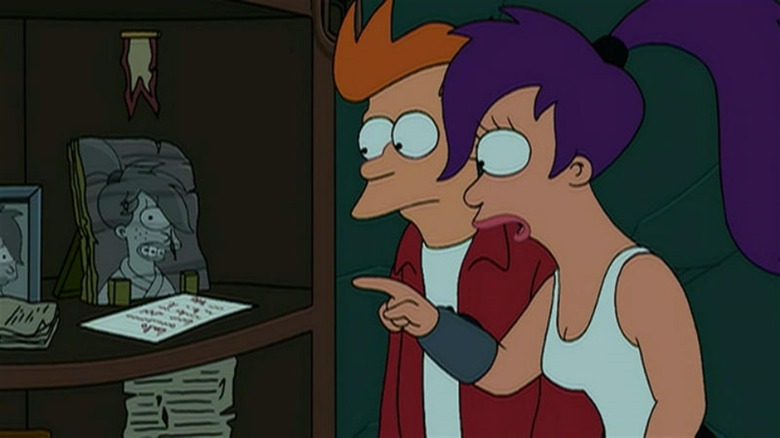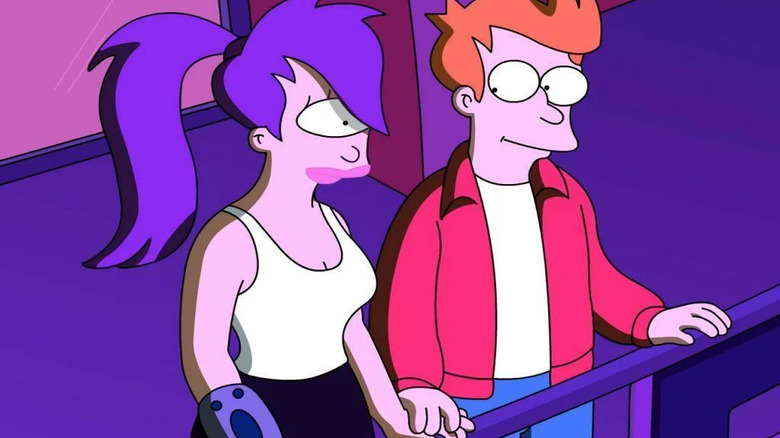Leela's Futurama Design Was A Jab At Sci-Fi Fanboys
By way of introduction, one might do well to recall the definition and the origin of the term "slash fiction." Slash fiction colloquially refers to fan-authored stories about licensed characters from established films or TV shows engaging in romantic or sexual couplings (or groups, as the case may be). The term comes from the 1970s, after the cancelation of "Star Trek," when such fan fiction began to boom in earnest. As a shorthand for the enterprising smut seeker, fan fiction could be referred to as K&S (for Kirk and Spock) or K/S (for Kirk slash Spock). The ampersand fiction denoted a friendship story, whereas the slash fiction denoted a queer romance or sex story. K/S zines became their own underground phenomenon, and other "slash" relationships soon followed (Yes, there were S/H stories featuring Starsky and Hutch). Once the internet came along, slash fiction became a cottage industry unto itself, eventually leading to "Twilight" slash fiction in the form of "Fifty Shades of Grey."
This is all to say that fetishizing characters in sci-fi and fantasy shows has long been de rigueur, a common feature of fandom. Having crushes on one of — or every — cast member of one's favorite sci-fi show is common and even expected; Here on /Film, we even once ranked "Star Trek" shows by their level of sexiness.
Matt Groening, the co-creator of "Futurama" knew this habit well, and knew that whatever characters he included on the show — notably the female ones — were destined to be sexualized. With that in mind, Groening designed the character of Leela as a deliberate mental poke at horny fanboys the world over. Groening said as much in a 2013 interview with the Los Angeles Times.
Beautiful Simpsons
The character of Turanga Leela, played by Katey Sagal, was constructed as the badass of "Futurama." She was a capable fighter and pilot, and could perhaps be seen as the Captain of the show. She was certainly the adult in the room, especially when paired with the dim bulb Fry (Billy West), or the self-absorbed alcoholic robot Bender (John DiMaggio).
Groening, whose under/overground comic strip "Life in Hell" debuted back in 1977, has long ago honed in on a style, notably that his characters tend to be drawn with an overbite (top lips often form sizeable shelves over the bottom lips), and chins are rarely a feature at all. Additionally, he draws large, bugged-out eyeballs and, in the case of "Life in Hell" or "The Simpsons," gives his characters large outsize rabbit ears or jaundice-like yellow skin (respectively). The idea of making a "sexy" or "beautiful" character in this style seemed antithetical to Groening.
In the Times, however, Groening admitted surprise when some of the show's designers were able to make Leela conventionally attractive:
"I learned that the animators could draw women in the 'Simpsons' style who looked beautiful, which was a great surprise to me! So I wanted to see if I could create a science-fiction heroine — except I wanted to mess with the fanboys, so I gave her one eye."
Mess with the fanboys? Oh, indeed.
Groening's penchant for outsize eyeballs was carried to a logical extreme with Leela, and Groening gave the character a single, enormous, melon-sized eyeball. Leela still had something of the Groening hanging lip, although less pronounced than on "The Simpsons." Knowing that fanboys would instantly sexualize Leela — by dint of her genre and her gender — Groening tried to give her a noticeably inhuman characteristic.
A sendup of sexualizing
In the canon of the show, Leela's one eye was was meant to denote her species. She had never met another cyclops, and had assumed she was alone in the galaxy, not knowing what happened to her species. As was later revealed, Leela was in fact human, albeit the child of cycloptic sewer mutants. Her mom had tentacles, while her father had a sideways sucker mouth. In the future of "Futurama," modern cities were built on the ruins of older cities where sewer mutants dwelled. Mutants were decent people who worshiped an unexploded nuclear bomb ("But it's mostly just an Easter-and-Christmas thing").
"Futurama," it should be stated, is fond of stripping all of its characters naked — in "Bender's Big Score," it's a plot point that the crew all visit the Nude Beach Planet — but it's less to titillate than to confront, as said in dialogue, stuffy old 20th-century notions of modesty. The nudity on "Futurama" is an antidote to certain sci-fi shows' tendency to get characters into skivvies in a clumsy attempt to infuse the proceedings with sexuality (cough, "Enterprise," cough). Every character was sexualized on the show, but mostly as a joke.
Given that Leela slash fiction does indeed exist, however (please don't look it up at work), perhaps Groening's clever conceit didn't quite work out the way he wanted. After all, we're humans. We can sexualize just about anything.


